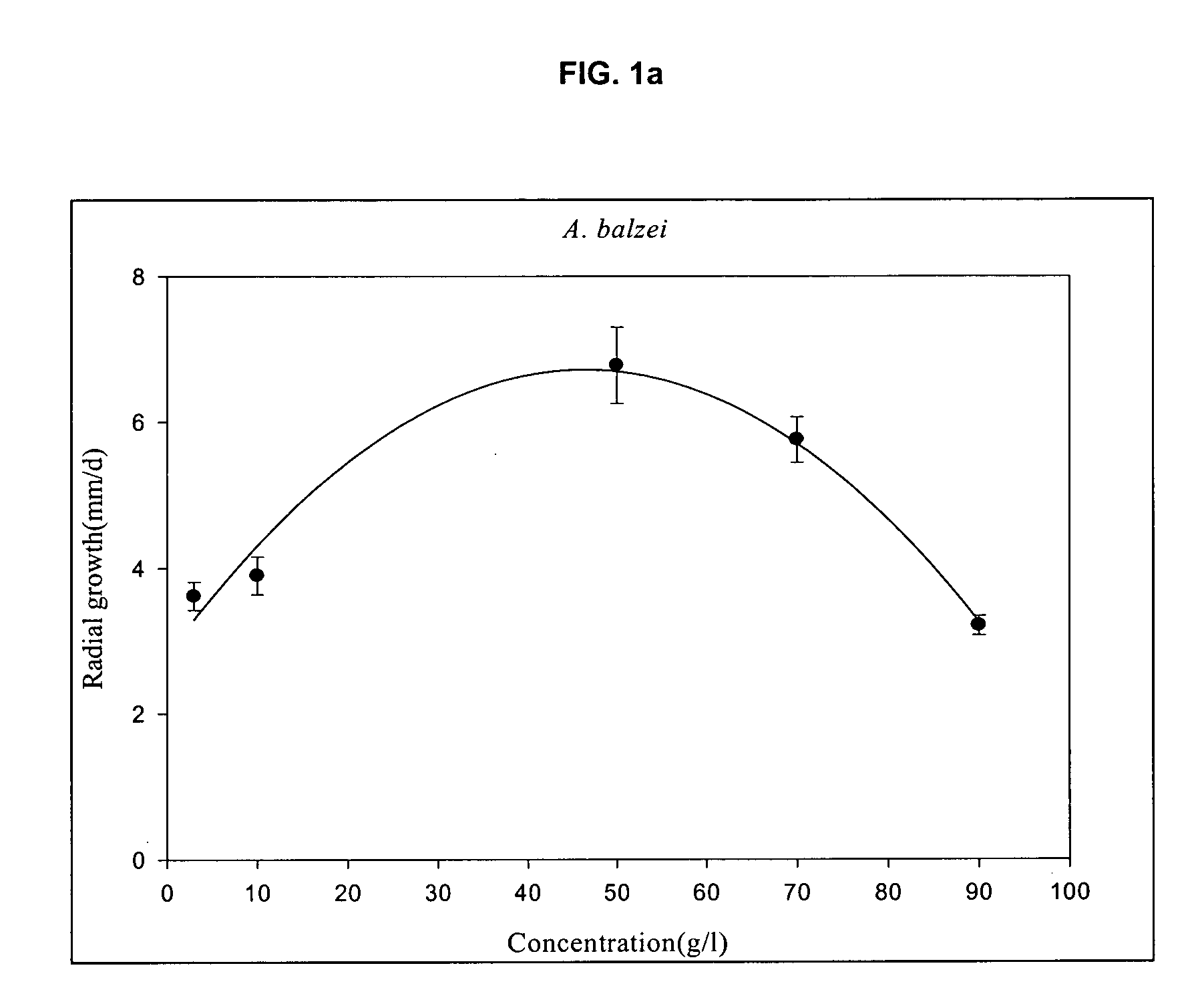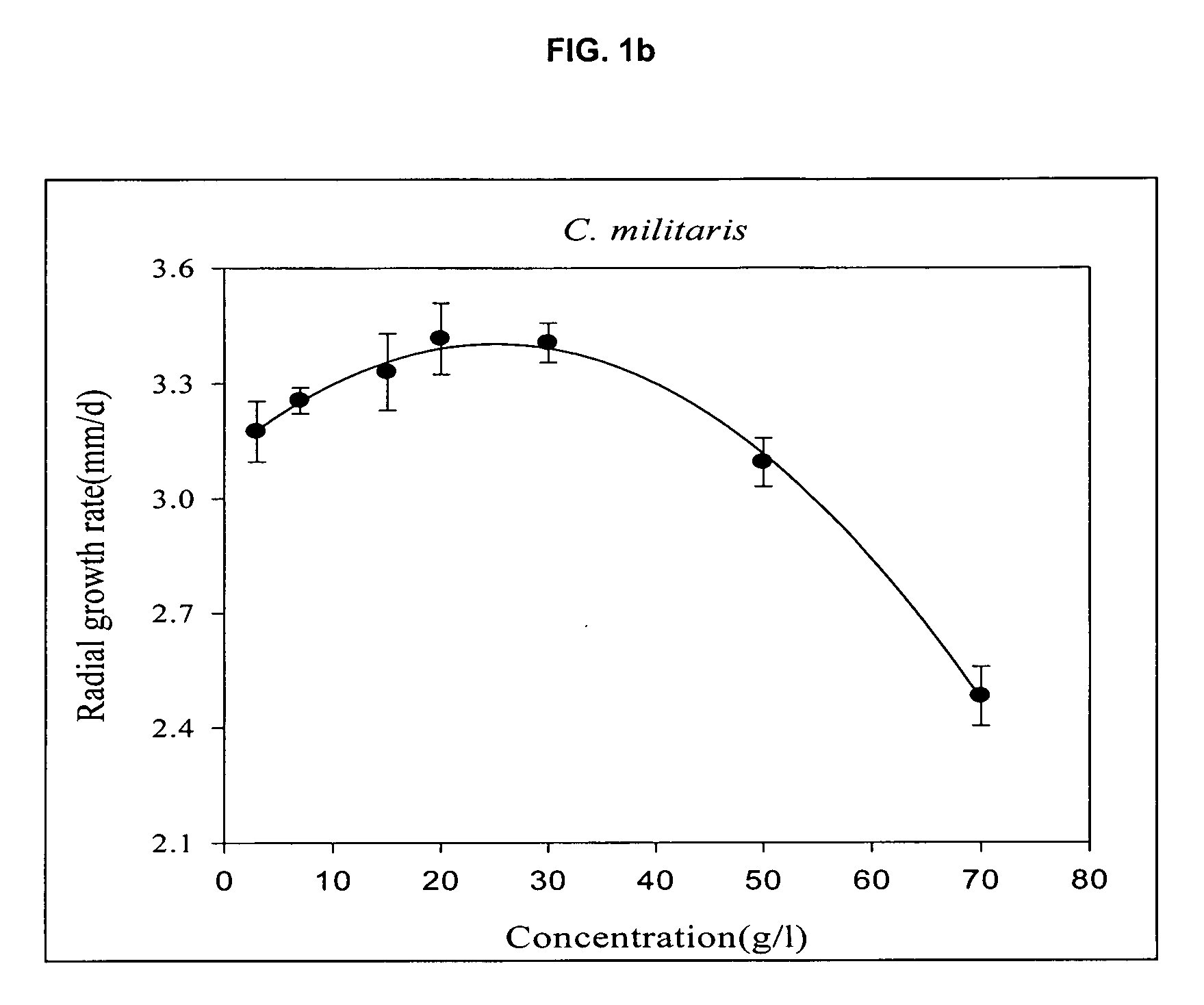Optimized fermentation process of mycelia on the solid medium of starch-processing waste
- Summary
- Abstract
- Description
- Claims
- Application Information
AI Technical Summary
Benefits of technology
Problems solved by technology
Method used
Image
Examples
example 1
Strains and Maintenance
[0021] Fungal strains used in the present invention, as shown in Table 1, were obtained from the Korean Culture Center of Microorganisms (KCCM) and the Korean Collection for Type Cultures (KCTC) of Korea Research Institute of Bioscience and Biotechnology (KRIBB). The fungal strains were sub-cultured on PDA (Potato Dextrose Agar) medium in Petri dishes in a 25° C. incubator. In order to maintain the strains in physiologically active exponential phase, the strains were continuously sub-cultured before mycelia would cover the whole medium in Petri dish.
TABLE 1Strain distributorsStrainNoNameDistributorNumber1Agaricus blazeiKorean Culture Center ofKCCMMurillMicroorganisms (KCCM)602572CordycepsKorean Collection for TypeKCTCmilitarisCultures (KCTC)64723Ganoderma lucidumKorean Collection for TypeKCTCCultures (KCTC)62834Lentinus edodesKorean Collection for TypeKCTCCultures (KCTC)67355Phellinus linteusKorean Collection for TypeKCTCCultures (KCTC)6719
example 2
Preparation of Sterilized Medium and Inoculation
[0022] Starch-processing waste was just dough before the pre-treatment. The dough was dried at 60° C. for 24 hours and pulverized to prepare media of wanted concentrations. The pulverized starch-processing waste was sterilized by autoclaving at 121° C. together with 1.5% agar, which was inoculated into Petri dishes in a germ-free chamber and then was solidified at room temperature. The most active region of each strain, which was kept in exponential phase in PDA medium, was cut by a 5 mm circular blade, and the resultant circular section was transferred onto the medium of starch-processing waste, which was then tightly sealed not to be contaminated.
example 3
Application Test of the Strains
[0023] Experiments were designed to confirm the possibility of growth of mycelia on starch-processing waste at 25° C. with optimum pH, proposed by earlier reports. Longitudinal growth rate was measured at different starch-processing waste concentrations of 3, 10, 30, 50, 70 and 90 g / L. Based on the growth rate at each concentration, mathematical polynomial expression calculating the growth rate of mycelia as seen in FIG. 1 was applied to determine optimum concentration, which was then used as a center point of central composite design.
TABLE 2Optimum substrate concentration and maximum specificgrowth rate of myceliaOptimum substrateMaximum specificNameconcentration (g / L)growth rate Kr(mm / d)Agaricus blazei46.46.7Cordyceps25.13.4Ganoderma33.213.2Lentinus edodes42.67.5Phellinus26.23.5
PUM
 Login to View More
Login to View More Abstract
Description
Claims
Application Information
 Login to View More
Login to View More - R&D
- Intellectual Property
- Life Sciences
- Materials
- Tech Scout
- Unparalleled Data Quality
- Higher Quality Content
- 60% Fewer Hallucinations
Browse by: Latest US Patents, China's latest patents, Technical Efficacy Thesaurus, Application Domain, Technology Topic, Popular Technical Reports.
© 2025 PatSnap. All rights reserved.Legal|Privacy policy|Modern Slavery Act Transparency Statement|Sitemap|About US| Contact US: help@patsnap.com



